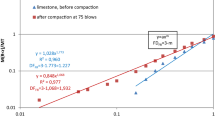Summary
On wet roads a sufficiently rough surface texture on the macroscale is necessary to ensure rapid removal of water from the contact zone between the tire and road surface, especially at high speeds.
For this surface texture on the macroscale, beside the particle size of the aggregate also the resistance to crushing and abrasion is rather important.
The macroroughness is likely to decrease rapidly in case of insufficient resistance to crushing which will cause destruction of stones at the surface. It decreases too, if the resistance to abrasion of stones, which protrude from the road surface, is poor.
The texture depth, which is a measure of the roughness on the macroscale, can easily be determined.
A satisfactory surface texture on the microscale is required as well, because this texture is at least largely determinant of the level of skid resistance. It is not yet possible to express the surface texture on the microscale in a number. The resistance to polishing of aggregates can, however, be expressed as the polished stone value which is determined in the laboratory using an apparatus for accelerated polishing.
The correlation between the polished-stone value and the skid resistance, i.e. the similarity with practice, appears to be good in cases in which the surface consists of a continuous mosaic of coarse aggregate such as in surface dressings.
Finally also the shape of the stone particles may be important for the skid resistance (unfractured faces in crushed gravel) and for the resistance to crushing (thin pieces).
Résumé
La surface mouillée d’autoroutes pose des problèmes quant à la texture, spécialement aux vitesses grandes; donc la résistance des aggrégats est très importante.
L’auteur a étudié la rélation entre l’influence du trafic et les propriétés des aggrégats.
La profondeur de la texture donne une indication de la rugosité à l’échelle—macro et peut être déterminée facilement.
A l’échelle—micro la texture est également importante, spécialement quant au frottement. Quoique une quantification de cette texture reste maintenant impossible, il y a de possibilités en laboratoire pour un polissage accéléré.
La corrélation entre les resultats en laboratoire et les mesures de la surface de la chaussée se trouve être bon.
Enfin il apparait que la forme des grains est un facteur important quant au comportement en pratique.
Similar content being viewed by others
References
LOWNE R.W. (1969): ”The effect of road surface texture on tyre wear”.—RRL Report LR 265.
SABEY B.E. (1965): ”Road surface characteristics and skidding resistance”.— The journal of the British Granite and Whinstone Federation, Vol. 5, 2, Autumn.
ROAD NOTE no. 27 (1969): Road Research Laboratory.
HOSKING J.R. — SZATKOWSKI W.S. (1972): ”The effect of traffic and aggregate on the skidding resistance of bituminous surfacings”.—TRRL Report LR 504.
”Eisen door de Rijkswaterstaat gesteld aan bouwstoffen voor de wegenbouw” (1972).
HOSKING J.R. (1970): ”Synthetic aggregates of high resistance to polishing, part 1 — Gritty aggregates”.—RRL Report LR 350.
Author information
Authors and Affiliations
Rights and permissions
About this article
Cite this article
Hogervorst, D. Some properties of crushed stone for road surfaces. Bulletin of the International Association of Engineering Geology 10, 59–64 (1974). https://doi.org/10.1007/BF02634635
Issue Date:
DOI: https://doi.org/10.1007/BF02634635




